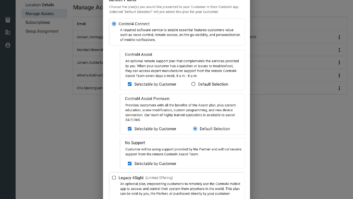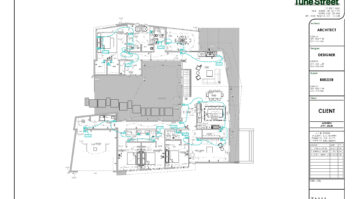As you begin reading this article we are about 630 days from what will become one of the most important dates in United States television broadcasting history: February 17, 2009. Barring any unforeseen Congressional or court actions, at midnight on that date, at your local time, television broadcasting stations will be required to cease their analog television broadcasts.
This end to 60-plus years of NTSC broadcasting has been long in the making with many technical and regulatory milestones checked off on the DTV Countdown list. As you read this, all broadcast stations (other than any with special exemptions) are broadcasting in both analog and digital. Many are also offering multiple sub-channels, and virtually all have at least some programming in high definition. The networks offer the vast majority of their prime-time schedules in HD, along with late-night programming, one prime-time newscast, two morning shows, most major sporting events, and even some daytime programming. Local stations are increasing their HD content, with more markets seeing news and other local programming in HD. Weve come a long way, baby!
The End is in Sight
On the product side, the tuner mandate is not complete, and since March manufacturers have been required to include a digital tuner in any product that has a traditional analog tuner. The reverse is not required, but we havent seen any products configured that way just yet. The tuner mandate signals that the end of the digital transition is really in sight. After all, remember that this is the digital transition, and as we are fond of saying, All high definition is digital, but not all digital is high-def. This is not just for broadcasters, who are not required to transmit HD signals, but do. It is also for what happens on the receiving end of the transmission path. There are countless millions and millions of analog sets that function perfectly well with the minor problem that they do not have the ability to tune in the digital signals that will be the only choice on February 18, 2009, along with the circuitry to convert the video to good, old-fashioned, 480i.
For many, particularly in the world of higher end clients, this is a call to simply replace all the existing analog sets in the home. But in many cases that is neither practical nor environmentally appropriate. For others, you can keep the existing analog sets and gamble that cable or satellite receivers will be available to carry digital off-air signals and convert them to analog. Yet, in still other applications, there will be no other choice for keeping an otherwise serviceable television or video display working than to use an off-air set top tuner/converter. Remember, in some installation locations there may simply be no other choice than terrestrial pick-up. Finally, particularly where budgetary considerations are important, the cost of buying a new TV may simply be out of the question.
Coupon Clipping Time
What to do? Thats where the NTIAs Digital-to-Analog Converter Box Coupon Program comes into play. The NTIA (National Telecommunications and Information Administration) is a branch of the Commerce Department that has the mission of administering the expenditure of up to $1.5 billion to fund the distribution and redemption of coupons that are redeemable for up to $40 each toward the purchase of specifically designed and featured set tops, or, in government speak, Coupon-Eligible Converter Boxes (CECBs). First announced back in March, though some of the inner workings are still being ironed out as key aspects of the program are put up for bid, the program will offer up to two voucher coupons for $40 to each home address in the U.S. that may be used toward the purchase of a specifically designed and designated set-top converter.
Those are the basics, but as always, the devil is very much in the details. First, lets look at how this impacts the average American familyyour clients and prospects.
Unlike some of the original proposals, the final plan makes every U.S. household eligible for the vouchers, regardless of whether or not they actually receive over-the-air television or if they also have cable or satellite service. The maximum is for two coupons per household, not per person, and sorry, since names will be cross matched, only two per household unit, even if there is more than one family address.
Coupons may be requested via the Internet, fax, a toll-free phone number, or snail mail, beginning January 1, 2008 up until March 31, 2009 and are good for 90 days, after which they expire. The dates are important because the coupons become worthless if requested too early and then not used. On the other hand, if the number of coupons requested exceeds a total of $990 million, or 24.75 million coupons, those requesting the balance of the 12.75 million coupons ($510 million) will be limited to households where over-the-air television is the only source of broadcast programming.
The $40 voucher does not include any sales tax on the transaction, and if the converter sells for less than $40 you dont get any change; if it sells for more, then you have to make up the difference. Two coupons may not be combined to purchase one converter, and obviously they may not be used for any other purchase, including antennae or digital televisions. (See sidebar for links to more information).
Converter Box Choices
What about the converter box itself? There are a variety of products that are, or will be available in the market to receive terrestrial DVT signals, but a CECB must meet a very specific set of requirements as to what it can and cannot do. High-end consumers often have different expectations than less affluent customers, so before getting involved in recommending, selling or installing these converters, it is important to know what the design specifies.
A CECB must tune channels 2 through 69 and display all DTV formats and accommodate all multicast channels. It has to display the program information, or PSIP, that is part of the digital signals and include a remote control. Required outputs are RF, composite analog video and left/right analog audio only via RCA plugs. An RF Cable with F connectors on each end must be included. The output will support 4:3 center cut-out of a 16:9 image, letterbox 16:9 or partially zoomed images.
A CECB may include a Smart Antenna input and offer electronic program guides and stereo in the RF output. Additional permitted, but not mandated features include the capability for software upgrades, a programmable remote and analog pass-through. An analog audio/video cable set may also be provided.
The catch for some might come in what a CECB may not include. Digital outputs for audio (S-P/DIF or via HDMI) or video (HDMI, DVI or 1394) are not allowed, and neither are analog Y/Pr/Pb components. The device may not include an integrated video display or any sort of audio/video recording or playback from tape, optical disc, or any other media. Consumers are permitted to buy only a CECB, and its sale may not be conditioned on the purchase of any other product or service.
Thus, the CECB is exactly what is it is intended to be: a means of tuning digital signals and converting them to a form that is compatible with any analog television receiver. Not fancy, but it will do the job.
Still interested? If you want to join in on the converter box party, as a retailer then you are also subject to certain rules, just as consumers and manufacturers are. First, you must havebeen in the consumer electronics business for at least one year. Then, two registrations are required. Before applying for eligibility to accept the vouchers you will need to register with the Federal Governments Central Contractor Registration database. Then, between June 1, 2007 and March 31, 2008 you will need to register for the program with the NTIA. As a participant in the program youll be expected to stock inventory of approved CECBs, provide training on the program for your staff, have the necessary electronic systems required to validate and accept the vouchers (which may take the form of something resembling gift cards, though the exact method will not be determined until a contractor is selected to administer the program), request ID from consumers presenting the coupons, agree to have coupon-supported sales audited, and follow the other rules required under the program.
Apply, become accepted, and follow the rules, and as part of the program your company will be part of the list of certified dealers that will be made available to the public through the educational activities associated with the program. There will, however, be audits along with the expectation that any rules in place will be followed. The NTIA will revoke certification of any retailer fund willfully non-compliant or engaged in fraudulent activities or practices.
To some, particularly if you deal only with an upper crust clientele, this may seem to be a burden just not worth the hassle. After all, you might ask yourself, Whats the value of two $40 coupons to someone spending tens or many hundreds of thousands of dollars on a home entertainment system? Perhaps, but the rich are also sometimes frugal.
Not every TV in the house will be replaced by the analog shutdown date, nor, perhaps should they be for non-critical viewing. One way or another there will be places where youll want to install simple converter boxes anyway, so why not provide a means to help cover the cost.
The Converter Box Coupon Program will be an interesting undertaking for all concernedconsumers, manufacturers, and those selling (and probably in your case, installing) the actual set-top boxes. There hasnt been any similar program on such a wide scale national level, and many will anxiously watch to see how it works out. Given the timing, begin to think now if you can, should, or want to become part of the program. If you do, let us know how it works for your business.
Michael Heiss ([email protected]) is an industry consultant in Los Angeles, California.







